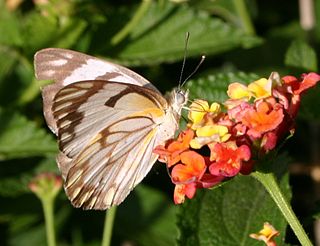
Butterflies (Rhopalocera) are insects that have large, often brightly coloured wings, and a conspicuous, fluttering flight. The group comprises the superfamilies Hedyloidea and Papilionoidea. The oldest butterfly fossils have been dated to the Paleocene, about 56 million years ago, though they may have originated earlier.

Lepidoptera is an order of insects that includes butterflies and moths. About 180,000 species of the Lepidoptera are described, in 126 families and 46 superfamilies, 10 percent of the total described species of living organisms. It is one of the most widespread and widely recognizable insect orders in the world. The Lepidoptera show many variations of the basic body structure that have evolved to gain advantages in lifestyle and distribution. Recent estimates suggest the order may have more species than earlier thought, and is among the four most species-rich orders, along with the Hymenoptera, Diptera, and Coleoptera.

Entomology is the scientific study of insects, a branch of zoology. In the past the term insect was less specific, and historically the definition of entomology would also include the study of animals in other arthropod groups, such as arachnids, myriapods, and crustaceans. This wider meaning may still be encountered in informal use.

Moths are a group of insects that includes all members of the order Lepidoptera that are not butterflies. They were previously classified as suborder Heterocera, but the group is paraphyletic with respect to butterflies and neither subordinate taxa are used in modern classifications. Moths make up the vast majority of the order. There are thought to be approximately 160,000 species of moth, many of which have yet to be described. Most species of moth are nocturnal, although there are also crepuscular and diurnal species.

The monarch butterfly or simply monarch is a milkweed butterfly in the family Nymphalidae. Other common names, depending on region, include milkweed, common tiger, wanderer, and black-veined brown. It is amongst the most familiar of North American butterflies and an iconic pollinator, although it is not an especially effective pollinator of milkweeds. Its wings feature an easily recognizable black, orange, and white pattern, with a wingspan of 8.9–10.2 cm (3.5–4.0 in). A Müllerian mimic, the viceroy butterfly, is similar in color and pattern, but is markedly smaller and has an extra black stripe across each hindwing.

A pupa is the life stage of some insects undergoing transformation between immature and mature stages. Insects that go through a pupal stage are holometabolous: they go through four distinct stages in their life cycle, the stages thereof being egg, larva, pupa, and imago. The processes of entering and completing the pupal stage are controlled by the insect's hormones, especially juvenile hormone, prothoracicotropic hormone, and ecdysone. The act of becoming a pupa is called pupation, and the act of emerging from the pupal case is called eclosion or emergence.

Asclepias is a genus of herbaceous, perennial, flowering plants known as milkweeds, named for their latex, a milky substance containing cardiac glycosides termed cardenolides, exuded where cells are damaged. Most species are toxic to humans and many other species, primarily due to the presence of cardenolides. However, as with many such plants, some species feed upon them or from them. The most notable of them is the monarch butterfly, which uses and requires certain milkweeds as host plants for their larvae.

Swallowtail butterflies are large, colorful butterflies in the family Papilionidae, and include over 550 species. Though the majority are tropical, members of the family inhabit every continent except Antarctica. The family includes the largest butterflies in the world, the birdwing butterflies of the genus Ornithoptera.

Pierini is a tribe of butterflies within the family Pieridae.

Samuel Hubbard Scudder was an American entomologist and paleontologist. He was a leading figure in entomology during his lifetime and the founder of insect paleontology in America. In addition to fossil insects, he was an authority on butterflies (Lepidoptera) and grasshoppers (Orthoptera).

Maria Sibylla Merian was a German entomologist, naturalist and scientific illustrator. She was one of the earliest European naturalists to document observations about insects directly. Merian was a descendant of the Frankfurt branch of the Swiss Merian family.

Insect migration is the seasonal movement of insects, particularly those by species of dragonflies, beetles, butterflies and moths. The distance can vary with species and in most cases, these movements involve large numbers of individuals. In some cases, the individuals that migrate in one direction may not return and the next generation may instead migrate in the opposite direction. This is a significant difference from bird migration.
Richard Lewington is a British wildlife artist renowned for his exquisite eye for detail, especially with lepidoptera.

Prodryas persephone is an extinct species of brush-footed butterfly, known from a single specimen from the Chadronian-aged Florissant Shale Lagerstätte of Late Eocene Colorado. P. persephone is the first fossil butterfly to be found in North America, and is exquisitely well preserved. Its closest extant relatives are the mapwings and African admirals of the genera Hypanartia and Antanartia, respectively.

Human interactions with insects include both a wide variety of uses, whether practical such as for food, textiles, and dyestuffs, or symbolic, as in art, music, and literature, and negative interactions including damage to crops and extensive efforts to control insect pests.

A butterfly house, conservatory, or lepidopterarium is a facility which is specifically intended for the breeding and display of butterflies with an emphasis on education. Some butterfly houses also feature other insects and arthropods. Butterfly houses are owned and operated by museums, universities, non-profit corporations, and private individuals as part of their residence; as well as small businesses that are owner operated.

Insects have found uses in art, as in other aspects of culture, both symbolically and physically, from ancient times. Artforms include the direct usage of beetlewing (elytra) in paintings, textiles, and jewellery, as well as the representation of insects in fine arts such as paintings and sculpture. Insects have sometimes formed characteristic features of artforms, as in Art Nouveau jewellery.

Pierina is a subtribe of cabbage whites, checkered whites, albatrosses in the family Pieridae. There are about 8 genera and 18 described species in Pierina.

Akito Y. Kawahara is an American and Japanese entomologist, scientist, and advocate of nature education, and the son of the modern conceptual artist On Kawara.


















